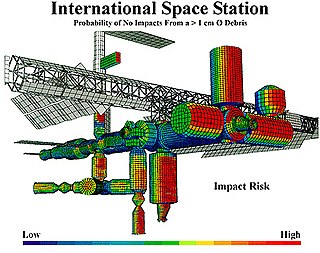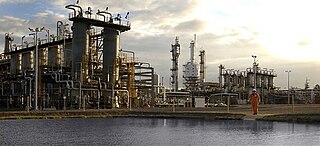Related Research Articles

Safety engineering is an engineering discipline which assures that engineered systems provide acceptable levels of safety. It is strongly related to industrial engineering/systems engineering, and the subset system safety engineering. Safety engineering assures that a life-critical system behaves as needed, even when components fail.

The Flixborough disaster was an explosion at a chemical plant close to the village of Flixborough, North Lincolnshire, England, on 1 June 1974. It killed 28 and seriously injured 36 of the 72 people on site at the time. The casualty figures could have been much higher if the explosion had occurred on a weekday, when the main office area would have been occupied. A contemporary campaigner on process safety wrote "the shock waves rattled the confidence of every chemical engineer in the country".
Process Safety Managementof Highly Hazardous Chemicals is a regulation promulgated by the U.S. Occupational Safety and Health Administration (OSHA). It defines and regulates a process safety management (PSM) program for plants using, storing, manufacturing, handling or carrying out on-site movement of hazardous materials above defined amount thresholds. Companies affected by the regulation usually build a compliant process safety management system and integrate it in their safety management system. Non-U.S. companies frequently choose on a voluntary basis to use the OSHA scheme in their business.
A piping and instrumentation diagram is a detailed diagram in the process industry which shows the piping and process equipment together with the instrumentation and control devices. It is also called as mechanical flow diagram (MFD).

On 25 September 1998 a catastrophic accident occurred at the Esso natural gas plant in Longford, Victoria, Australia. A pressure vessel ruptured resulting in a serious jet fire, which escalated to a conflagration extending to a large part of the plant. Fires lasted two days before they were finally extinguished.
In functional safety, safety integrity level (SIL) is defined as the relative level of risk-reduction provided by a safety instrumented function (SIF), i.e. the measurement of the performance required of the SIF.
A hazard analysis is used as the first step in a process used to assess risk. The result of a hazard analysis is the identification of different types of hazards. A hazard is a potential condition and exists or not. It may, in single existence or in combination with other hazards and conditions, become an actual Functional Failure or Accident (Mishap). The way this exactly happens in one particular sequence is called a scenario. This scenario has a probability of occurrence. Often a system has many potential failure scenarios. It also is assigned a classification, based on the worst case severity of the end condition. Risk is the combination of probability and severity. Preliminary risk levels can be provided in the hazard analysis. The validation, more precise prediction (verification) and acceptance of risk is determined in the risk assessment (analysis). The main goal of both is to provide the best selection of means of controlling or eliminating the risk. The term is used in several engineering specialties, including avionics, food safety, occupational safety and health, process safety, reliability engineering.
In the chemical and process industries, a process has inherent safety if it has a low level of danger even if things go wrong. Inherent safety contrasts with other processes where a high degree of hazard is controlled by protective systems. As perfect safety cannot be achieved, common practice is to talk about inherently safer design. “An inherently safer design is one that avoids hazards instead of controlling them, particularly by reducing the amount of hazardous material and the number of hazardous operations in the plant.”
IEC 61508 is an international standard published by the International Electrotechnical Commission (IEC) consisting of methods on how to apply, design, deploy and maintain automatic protection systems called safety-related systems. It is titled Functional Safety of Electrical/Electronic/Programmable Electronic Safety-related Systems.
IEC standard 61511 is a technical standard which sets out practices in the engineering of systems that ensure the safety of an industrial process through the use of instrumentation. Such systems are referred to as Safety Instrumented Systems. The title of the standard is "Functional safety - Safety instrumented systems for the process industry sector".
In functional safety a safety instrumented system (SIS) is an engineered set of hardware and software controls which provides a protection layer that shuts down a chemical, nuclear, electrical, or mechanical system, or part of it, if a hazardous condition is detected.
Trevor Asher Kletz, OBE, FREng, FRSC, FIChemE was a prolific British author on the topic of chemical engineering safety. He was a central figure in establishing the discipline of process safety. He is credited with introducing the concept of inherent safety and was a major promoter of Hazop. He is listed in The Palgrave Dictionary of Anglo-Jewish History.

The Institution of Chemical Engineers (IChemE) is a global professional engineering institution with 30,000 members in 114 countries. It was founded in 1922 and awarded a Royal Charter in 1957.
Process safety is an interdisciplinary engineering domain focusing on the study, prevention, and management of large-scale fires, explosions and chemical accidents in process plants or other facilities dealing with hazardous materials, such as refineries and oil and gas production installations. Thus, process safety is generally concerned with the prevention of, control of, mitigation of and recovery from unintentional hazardous materials releases that can have a serious effect to people, plant and/or the environment.
A process hazard analysis (PHA) (or process hazard evaluation) is an exercise for the identification of hazards of a process facility and the qualitative or semi-quantitative assessment of the associated risk. A PHA provides information intended to assist managers and employees in making decisions for improving safety and reducing the consequences of unwanted or unplanned releases of hazardous materials. A PHA is directed toward analyzing potential causes and consequences of fires, explosions, releases of toxic or flammable chemicals and major spills of hazardous chemicals, and it focuses on equipment, instrumentation, utilities, human actions, and external factors that might impact the process. It is one of the elements of OSHA's program for Process Safety Management.
Functional safety is the part of the overall safety of a system or piece of equipment that depends on automatic protection operating correctly in response to its inputs or failure in a predictable manner (fail-safe). The automatic protection system should be designed to properly handle likely systematic errors, hardware failures and operational/environmental stress.
ISO 26262, titled "Road vehicles – Functional safety", is an international standard for functional safety of electrical and/or electronic systems that are installed in serial production road vehicles, defined by the International Organization for Standardization (ISO) in 2011, and revised in 2018.
ISO/IEC 31010 is a standard concerning risk management codified by The International Organization for Standardization and The International Electrotechnical Commission (IEC). The full name of the standard is ISO.IEC 31010:2019 – Risk management – Risk assessment techniques.
A cyber PHA or cyber HAZOP is a safety-oriented methodology to conduct a cybersecurity risk assessment for an industrial control system (ICS) or safety instrumented system (SIS). It is a systematic, consequence-driven approach that is based upon industry standards such as ISA 62443-3-2, ISA TR84.00.09, ISO/IEC 27005:2018, ISO 31000:2009 and NIST Special Publication (SP) 800-39.
Layers of protection analysis (LOPA) is a technique for evaluating the hazards, risks and layers of protection associated with a system, such as a chemical process plant. In terms of complexity and rigour LOPA lies between qualitative techniques such as hazard and operability studies (HAZOP) and quantitative techniques such as fault trees and event trees. LOPA is used to identify scenarios that present the greatest risk and assists in considering how that risk could be reduced.
References
- 1 2 3 4 IEC (2016). Hazard and Operability Studies (HAZOP studies) – Application Guide. International Standard IEC 61882 (2.0 ed.). Genève: International Electrotechnical Commission. ISBN 978-2-8322-3208-8.
- 1 2 3 4 5 Kletz, Trevor A. (1983). HAZOP & HAZAN. Notes on the Identification and Assessment of Hazards (2nd ed.). Rugby: IChemE.
- ↑ Kletz, Trevor (2000). By Accident... A Life Preventing Them in Industry. PFV Publications. ISBN 0-9538440-0-5
- ↑ Lawley, H.G. (1974). "Operability Studies and Hazard Analysis". Chemical Engineering Progress. 70(4): 105-116.
- ↑ Chemical Industry Safety and Health Council (1977). A Guide to Hazard and Operability Studies. London: Chemical Industries Association
- ↑ Swann, C. D.; Preston, M. L. (1995). "Twenty-five Years of HAZOPs". Journal of Loss Prevention in the Process Industries.8(6): 349-353
- ↑ Crawley, Frank; Tyler, Brian (2015). HAZOP: Guide to Best Practice (3rd ed.). Amsterdam, etc.: Elsevier. ISBN 978-0-323-39460-4.
- ↑ Nolan, Dennis P. (1994) Application of HAZOP and What-If Safety Reviews to the Petroleum, Petrochemical and Chemical Industries. Park Ridge, N.J.: Noyes Publications. ISBN 0-8155-1353-4.